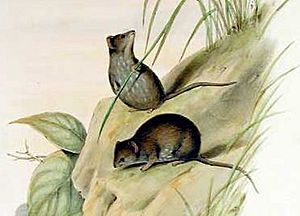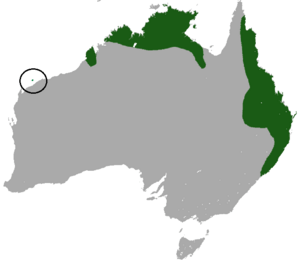Pygmy planigale facts for kids
Quick facts for kids Common planigale |
|
|---|---|
 |
|
| Conservation status | |
| Scientific classification | |
| Genus: |
Planigale
|
| Species: |
maculata
|
 |
|
| Common planigale range | |
The common planigale (Planigale maculata) is a tiny Australian animal. It is also called the pygmy planigale or the coastal planigale. This small creature is a type of marsupial carnivore. Marsupials are animals that carry their young in a pouch. The common planigale is often called a "marsupial mouse" because of its size. It lives in Australia and eats insects, much like insect-eating animals in other parts of the world.
Contents
What is a Common Planigale?
The common planigale is a small mammal found in Australia. It belongs to a group of animals called dasyurids. These are meat-eating marsupials. The common planigale is one of the smallest marsupials. It helps control insect populations in its habitat.
Naming and Family Tree
The common planigale was first described by John Gould in 1851. At first, it was placed in a different group of animals. Later, in 1976, a scientist named Mike Archer moved it to the Planigale genus. The scientific name, Planigale maculata, means "spotted flat-weasel."
There are two types, or subspecies, of common planigales:
- P. m. maculata: This type lives on mainland Australia.
- P. m. sinualis: This type is found on Groote Eylandt, an island.
Physical Description
The common planigale looks a bit like a mix between a mouse and a shrew. Its body is covered in soft fur. The fur on its tail is not as thick as on its body. Its belly is a light grayish-yellow color. The rest of its fur can be gray or a cinnamon color.
This planigale is the biggest of its kind. Its head and body together are about 100 millimeters (4 inches) long. Its tail is about 80 millimeters (3 inches) long. Males usually weigh about 15 grams (0.5 ounces). Females are a bit lighter, weighing around 11 grams (0.4 ounces). The common planigale has a very narrow, flat head. This helps it squeeze into tight spaces. Female planigales have a well-formed pouch. This pouch opens towards the back of their body.
Life Cycle and Reproduction
The common planigale's gestation period is short, lasting 19 to 20 days. After this time, the female gives birth to 5 to 11 babies. The number of babies often matches the number of teats the mother has. The young are born very tiny and undeveloped. They crawl into their mother's pouch. There, they attach to a teat and drink milk until they grow bigger.
Young planigales leave the pouch when they are about 28 days old. They start eating solid food around 55 days old. By 70 days, they can live on their own. They begin to have their own babies when they are about 290 days old. This is later than many similar small animals. Males can continue to breed until they are at least 24 months old. Females can have several litters of babies each year. In zoos, they can breed all year long.
Behaviour
The common planigale lives on the ground. It likes places with thick plants to hide from predators. Its flat head helps it move through small cracks, holes, and thick grass. This allows it to escape danger or hunt for food quickly. Sometimes, several planigales might share a nest. In captivity, females build small, saucer-shaped nests. They use bark and grass for these nests. Scientists think they do the same in the wild.
These animals are mostly nocturnal. This means they are active at night. However, in winter, they might come out during the day to find food. This happens if the weather is good. If conditions are bad, they can enter a state called torpor. Torpor is like a deep sleep. Their body slows down a lot. Their breathing rate drops from 100 breaths per minute to 15-30 breaths per minute. Most animals enter torpor when there isn't enough food. But common planigales can do it even when there's plenty of food. This suggests that air temperature might be the main reason they go into torpor. When in torpor, they curl up on their sides. They tuck their heads into their stomachs.
Diet
The common planigale mainly eats insects and other arthropods. Arthropods include creatures like spiders and centipedes. Sometimes, they might also eat small animals like lizards or birds. Because they are small, common planigales usually prefer smaller insects. These are typically less than 15 millimeters (0.6 inches) long. However, they can catch bigger prey. This includes large beetles and especially grasshoppers. To kill an insect, they bite its soft underside. In zoos, they eat mealworms, dog food, eggs, honey, and minced meat.
Where They Live and Their Home
The common planigale lives in many parts of Australia. You can find them from the upper Hunter River valley near Sydney. They live along the coast and inland areas up to Cape York. They are also found across the Top End of Australia to the Kimberley region. They also live on Groote Eylandt and Great Keppel Island. On Great Keppel Island, their survival is at risk due to planned building projects.
These planigales live in more types of places than other planigale species. They can be found in sclerophyll forests, rainforests, marshlands, and grasslands. They even live in the outer parts of Brisbane. Sometimes, people mistakenly trap them there, thinking they are house mice. In all these places, they like areas with thick plant cover and close to water.
Conservation Status
We do not know the exact number of common planigales in the wild. However, scientists do not believe the species is in danger. It is not listed as a threatened animal.
See also
 In Spanish: Planigale maculata para niños
In Spanish: Planigale maculata para niños



